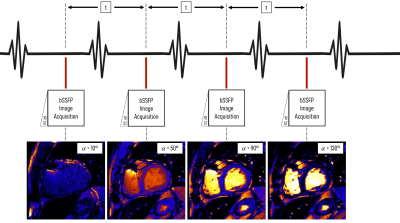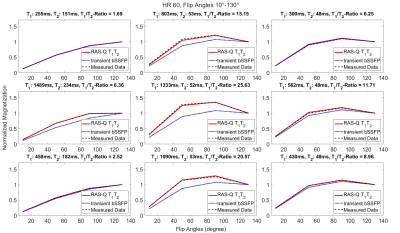Céline Marquet1,2,3, Jihye Jang1,2,4, Andrew J. Powell1,2, and Mehdi H. Moghari1,2
1Department of Pediatrics, Harvard Medical School, Boston, MA, United States, 2Department of Cardiology, Boston Children's Hospital, Boston, MA, United States, 3Department of Informatics, Technical University Munich, Munich, Germany, 4Philips Healthcare, Boston, MA, United States
1Department of Pediatrics, Harvard Medical School, Boston, MA, United States, 2Department of Cardiology, Boston Children's Hospital, Boston, MA, United States, 3Department of Informatics, Technical University Munich, Munich, Germany, 4Philips Healthcare, Boston, MA, United States
RAS-Q T1T2 combines
transient bSSFP with variable flip angles for simultaneous myocardial T1
and T2 quantification at a rapid scan time (≤ 4s). It shows accurate
T2 quantification, lower T2 precision, and lower T1
accuracy and precision.

Figure 1: RAS-Q T1T2
pulse sequence acquisition scheme. Four images are
acquired in the same diastolic phases within 4 consecutive heartbeats (t). Each
image is acquired with a different flip angle (α = [10°, 50°, 90°, 130°]) after
ten linear startup pulses (ST). All further sequence parameters are kept
constant (TR/TE: 2.96/1.48ms, CS-SENSE: 3). Image
acquisition is performed during breath-hold in ≤4s.

Figure
2: Magnetization
curves for different T1/T2 ratios. Graphs show
normalized magnetization evolution over flip angles from 10°-130° for 9
different tubes of the T1MES phantom.15 Measured mean pixel
intensity (black, dashed curves) is compared to theoretical values of RAS-Q T1T2
(red curve) and the transient bSSFP function (blue, dotted curves). Results are
depicted for heartrate 60bpm. Measured RAS-Q T1T2 pixel
intensities demonstrate a close alignment to expected theoretical values over
different T1/T2 ratios and heartrates.